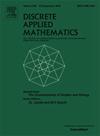图积的循环凸性的复杂度和结构结果及凸数
IF 1
3区 数学
Q3 MATHEMATICS, APPLIED
引用次数: 0
摘要
设G为图,S⊥V(G)。在环凸性中,我们说S是环凸,如果对于任意u∈V(G)∈S, S的归纳子图∪{u}不包含包含u的环。S的环凸包是包含S的最小凸集。G的环凸包数,用hncc(G)表示,是使S的凸包为V(G)的最小集S的基数。G的环凸数用concc(G)表示,它是V(G)的固有环凸集的最大基数。本文研究了图积中的循环凸性。我们证明,对于强产品和词典产品,循环壳体数总是2。对于笛卡尔坐标系,我们建立了该乘积的紧边界,并提供了因子为树时的封闭公式,推广了网格图的现有结果。此外,在给定图G和整数k的情况下,证明了即使G是二部笛卡尔积图,hncc(G)≤k也是np完全的,解决了文献中的一个开放问题。进一步给出了这三种图积的圈凸数的精确公式。当给定一个图G和一个整数k,当G是笛卡尔积图、强积图或字典积图时,决定conc (G)是否≥k,这就导致了np完备性。本文章由计算机程序翻译,如有差异,请以英文原文为准。
Complexity and structural results for the hull and convexity numbers in cycle convexity for graph products
Let be a graph and . In the cycle convexity, we say that is cycle convex if for any , the induced subgraph of contains no cycle that includes . The cycle convex hull of is the smallest convex set containing . The cycle hull number of , denoted by , is the cardinality of the smallest set such that the convex hull of is . The cycle convexity number of , denoted by , is the maximum cardinality of a proper cycle convex set of . This paper studies cycle convexity in graph products. We show that the cycle hull number is always two for strong and lexicographic products. For the Cartesian, we establish tight bounds for this product and provide a closed formula when the factors are trees, generalizing an existing result for grid graphs. In addition, given a graph and an integer , we prove that is NP-complete even if is a bipartite Cartesian product graph, addressing an open question in the literature. Furthermore, we present exact formulas for the cycle convexity number in those three graph products. That leads to the NP-completeness of, given a graph and an integer , deciding whether , when is a Cartesian, strong or lexicographic product graph.
求助全文
通过发布文献求助,成功后即可免费获取论文全文。
去求助
来源期刊

Discrete Applied Mathematics
数学-应用数学
CiteScore
2.30
自引率
9.10%
发文量
422
审稿时长
4.5 months
期刊介绍:
The aim of Discrete Applied Mathematics is to bring together research papers in different areas of algorithmic and applicable discrete mathematics as well as applications of combinatorial mathematics to informatics and various areas of science and technology. Contributions presented to the journal can be research papers, short notes, surveys, and possibly research problems. The "Communications" section will be devoted to the fastest possible publication of recent research results that are checked and recommended for publication by a member of the Editorial Board. The journal will also publish a limited number of book announcements as well as proceedings of conferences. These proceedings will be fully refereed and adhere to the normal standards of the journal.
Potential authors are advised to view the journal and the open calls-for-papers of special issues before submitting their manuscripts. Only high-quality, original work that is within the scope of the journal or the targeted special issue will be considered.
 求助内容:
求助内容: 应助结果提醒方式:
应助结果提醒方式:


